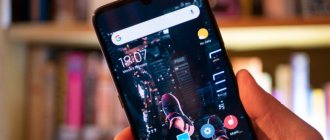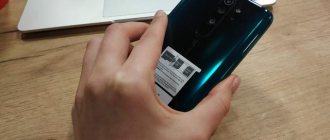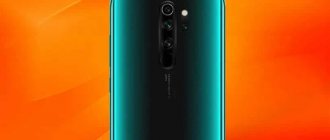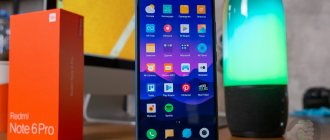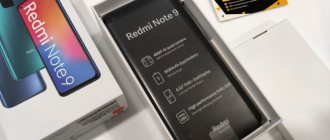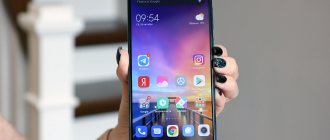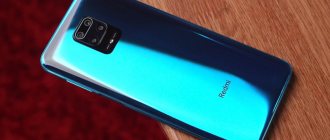Redmi Note 8 Pro firmware
The Redmi Note 8 Pro smartphone is codenamed Begonia, Begoniain. Release date: September 24, 2022.
This is the most advanced modification of Redmi 8. The model has excellent cameras and good battery life. True, the processor installed here is not from Qualcomm, but from MTK. But this only affected performance for the better.
The back panel of the case is made of glass; its design is very similar to that of the Redmi 8 and shimmers beautifully in the sun. The frame around the screen is plastic. The front camera is located in a small drop on the display. There is even a 3.5 mm mini-jack for connecting wired headphones to your smartphone.
The Indian version is codenamed Begoniain. With the ending IN, unlike other markets where the phone is simply Begonia.
- Display 6.53″, 1080 x 2340 px
- Processor MediaTek Helio G90T
- RAM 8 GB
- Battery 4500 mAh
- Main camera 64 MP + 8 MP + 2 MP + 2 MP
- Selfie camera 20 MP
- Operating system MIUI 12.5, Android 11
- Test AnTuTu v8 292510
Redmi Note 8 Pro models:
Global (M1906G7G): 6 GB 64 GB 6 GB 128 GB 8 GB 128 GB 8 GB 256 GB China (M1906G7E, M1906G7T): 6 GB 128 GB India (M1906G7I): 6 GB 64 GB 6 GB 128 GB 8 GB 128 GB
Performance
The eight-core MediaTek Helio G90T (MT6785T) processor, made using a 12 nm process technology, is the heart of the smartphone. Its design features both high-performance and energy-efficient cores. The graphics are powered by the Mali-G76 3EEMC4 adapter, which operates at a standard frequency of 800 MHz. This allows you to run the latest games.
RAM standard LPDDR4X is characterized by high performance and sufficient energy efficiency. The amount of RAM depends on the specific modification. There is no particular point in purchasing the 8 GB version of RN8 Pro, since 6 GB of RAM is sufficient for all tasks.
The internal storage is UFS 2.1 type. This is the most current, high-performance and energy-efficient type of memory. Its operating speed is tens of times faster than the fastest flash drive. The smartphone also has a slot for a memory card, but it can only be installed instead of one of the SIM cards. Therefore, it is better to choose a model with the maximum amount of built-in storage.
| Chipset | MediaTek Helio G90T |
| CPU | 8 Octa Cores: 2 Cortex A76 2.05 GHz and 6 Cortex A55 2.0 GHz |
| Maximum frequency | 2.05 GHz |
| Architecture | x64 |
| Graphics accelerator | Mali-G76 3EEMC4 GPU |
| RAM (max) | 8 GB |
| Built-in memory (max) | 256 GB |
| Memory card support | Yes |
Redmi Note 8 Pro test results in AnTuTu v8 Benchmark: 292510
points.
The result is shown for a smartphone model with 8 GB of RAM. See the full AnTuTu rating for Xiaomi smartphones. TOP 5 productive Xiaomi smartphones according to AnTuTu rating:
- 1
Xiaomi 12 Pro1070033 points
- 2
Redmi K50 Gaming1061295 points
- 3
Xiaomi 121027337 points
- 4
Black Shark 4 Pro867578 points
- 5
POCO F3 Pro821847 points
Xiaomi Redmi Note 8 Pro smartphone review
Table of contents
- Introduction
- Specifications
- Packaging and equipment
- Appearance and design
- Display
- Hardware platform and performance
- Software and firmware
- Safety
- Multimedia
- Wireless Interfaces and Communications
- File system
- Battery life
- Camera
- Comparison with competitors
- Conclusion
Introduction
Xiaomi is known all over the world for its affordable smartphones with very good characteristics.
And the main role in this process was given to the line of affordable Redmi smartphones. Users appreciate how nice it is to get a smartphone significantly cheaper than competitors without sacrificing performance. And Russian users were no exception, quickly elevating Xiaomi Redmi smartphones to the status of excellent (if not the best) offers in the budget segment. Not long ago, the Chinese company announced the separation of the Redmi name into a separate brand. Now this is not just the name of a model line, it is an independent brand among smartphones. However, in practice this did not bring significant changes. And this is not so important for users, the main thing is that smartphones still remain affordable and well-equipped.
Thanks to the Gadget Page, we will get acquainted with one of the new products of the Redmi brand, which is quite sensational and very promising. We are talking about the Redmi Note 8 Pro smartphone. The name itself actively hints that the device should be large and have advanced capabilities.
It remains only to find out how justified its name is and how well it performs the tasks assigned to it. First, let's look at the technical characteristics of the model.
Specifications
announcements and advertising
RTX 3070 Ti Aorus at a non-Ti price
RTX 3080 for 288 tr in Citylink
RTX 3090 MSI for 539 TR
Earn money by participating in the content of our site
Another 3080 is even cheaper - see the price
Cool 3060 Ti Gigabyte Aorus fell in price 2 times
| Device type | Smartphone |
| Model | Redmi Note 8 Pro |
| CPU | MediaTek Helio G90T |
| Video processor | Mali-G76 MC4 |
| Memory, GB | Operational: 6; Main: 64 |
| Screen | 6.53″ IPS, 2340 x 1080 |
| Cameras, Mpix | Front: 20; Main: 64+8+2+2 |
| MicroSD support | Yes (instead of the second SIM) |
| NFC | Yes |
| Battery, mAh | 4 500 |
| Dimensions, mm | 161.0 x 76.0 x 8.8 |
| Weight, g | 200 |
| price, rub. | ~15 500 / 17990* |
*Approximate cost of European versions/official cost of certified copies.
Yes, the new device cannot be called compact, although it is not huge. The case is of medium size, but the weight of 200 g seems large. The device is built on the basis of a modern central processor and has fairly large amounts of memory, and the number of cameras here is quite modern.
Packaging and equipment
The packaging is made of thick white cardboard with a typical design - the main part and the lid. There are no questions about the quality of the materials used. And the assembly was done accurately and efficiently. The cover is tightly fixed in place, creating a safe space for the smartphone and protecting it from damage during transportation.
The front side shows the device itself from the front and back sides. The name of the smartphone is also indicated here. Although Redmi is now a separate brand, there was also a place for the Xiaomi brand logo.
On one of the side faces you can see a sticker with identification information, as well as information about color modification and memory capacity. Based on this information, there is a smartphone inside with the color “Mineral Gray”, while on the cover there is a smartphone in white color. By using the same packaging for smartphones of different colors, the manufacturer was able to save money.
The delivery package is quite typical for modern smartphones and includes only a basic set of accessories. So, in the box we found a power adapter with a European plug and a USB Type C cable. They are located in separate sections and come with their own packaging.
In accordance with the latest trends, the manufacturer also provided a protective silicone case. It is made translucent, black with a glossy surface. Even if it gets dirty, this case retains its decent appearance and perfectly protects the entire body from any damage.
The package includes:
- Power adapter;
- USB Type C cable;
- Silicone protective case;
- Key-clip for removing the slot for SIM cards and memory cards;
- Documentation.
There were no breakthroughs in the matter of packaging and packaging. But the high quality of workmanship has been preserved. The contents are reliably protected and will not be damaged in any way during transportation. But the factory seal stickers never appeared. This is quite typical for many Chinese manufacturers, but it still remains not the most logical solution. The massive appearance of protective covers in the standard package is encouraging. After all, adding a completely inexpensive accessory immediately eliminates the need for a large number of users to look for a protective case immediately after purchase in order to keep their smartphone intact.
Appearance and design
The manufacturer did not come up with anything innovative and used the classic candy bar form factor with a touch screen, without any additional moving parts or mechanisms. The body itself is made of glass and plastic. The front and back panels are made of Corning Gorilla Glass 5.
Three body color options are available. Classic white and gray, as well as dark green.
When turned off, the outline of the display is only barely visible against the background of black frames. If you turn on the device, the side frames become noticeable. By modern standards, they cannot be called record narrow, but they do not qualify as wide either. This is just a typical average among modern smartphones of this class.
At the top of the display there is a drop-shaped protrusion in which the front camera has found its place. It was also possible to place an LED notification indicator here, and at the junction of the glass panel with the side frame there is a speaker grille.
The ends are united by a single plastic frame with a rounded profile. The material successfully imitates metal and is practically indistinguishable from it during operation. The glass panels fit precisely to the frame, with virtually no gaps.
Mechanical power and volume control buttons are located at the top of the right side. At the bottom end there is a USB-C power connector, as well as the main speaker and an AUX jack for connecting a wired headset. Next to the main speaker grille there is also a single hole for a conversational microphone.
The top face received significantly fewer elements. Here you can only see a hole for an additional microphone and an infrared port for controlling household appliances. At the top of the left side you can see a slot for SIM cards and memory cards.
The back side is covered with a glass panel with rounded edges. They flow smoothly into the side frame, creating the feeling of a monolithic structure.
Where we are used to seeing the Xiaomi logo, the Redmi logo now flaunts. However, the mention of the Chinese company itself is still present, only the font has become smaller.
For testing, we received a version with a blue-gray color scheme. There are no fashionable gradient shimmers here, but the light is beautifully scattered across the lid, creating a pattern from a large number of individual strips of light.
At the top of the cover are the main camera lenses and a fingerprint scanner. They are placed on a common “island” located along the axis of the body. Nearby we can see an LED flash and another auxiliary module of the main camera.
Under the fingerprint scanner you can see marks about the resolution of the main camera of 64 megapixels and the use of artificial intelligence technology.
The smartphone has a classic design for most modern smartphones. However, nowadays most of them are similar to each other. Among the positive aspects, we note the good build quality of the case and the presence of protection against dust and moisture getting inside the case. There are no backlashes or gaps between the elements. The use of uniform colors helped to create a strict and stylish look for the smartphone, and it was possible to add attractiveness to it thanks to the interesting dispersion of light in the form of individual thin stripes.
Display
An IPS display with a diagonal of 6.53 inches and a resolution of 2340 x 1080 pixels is used. The pixel density is 395 ppi. Following the contours of the body, the display has rounded corners and the same thickness of frames on top and sides. The bottom frame is made a little wider.
At the top of the display there is a small teardrop-shaped protrusion that houses the front camera and LED event indicator. Not all applications are optimized to use the entire display area; some limit the usable area to this protrusion.
Even in sunny weather, the image does not fade, readability remains at a high level. This is supported by the use of the necessary light filters.
The image is perceived as contrasty and natural with a good range of shades.
The viewing angles are also pleasing. The image does not change brightness and color shades, only losing a little in the brightness of the backlight.
White color has a pronounced bluish tint, exhibiting an excessively “cold” color temperature. However, this does not affect the overall color rendition.
Black also has a bluish tint when viewed from the right angle and a slightly pinkish tint when viewed from an angle.
Using a colorimeter, we measured the brightness of the display backlight and tested the quality of the factory color calibration.
| Brightness level, % | White brightness, cd/m2 | Black brightness, cd/m2 | Contrast, x:1 |
| 100 | 508 | 0.394 | 1289 |
| 75 | 395 | 0.299 | 1321 |
| 50 | 264 | 0.201 | 1313 |
| 25 | 132 | 0.101 | 1307 |
| 0 | 1 | 0 | ? |
High contrast ratios are achieved by a solid reserve of brightness and almost zero brightness of the black field backlight. This is a very good result for an IPS display.
The graphs repeat each other as accurately as possible and are located at a minimum distance from the reference indicator.
Here, too, the graphs are pleasing with their stability and slight distance from the reference indicator.
The color temperature exceeds the standard by a quite typical 1500 K. A classic situation for modern screens.
The color range turned out to be slightly wider than the generally accepted RGB space. The expansion of the range of shades is observed at the tops of red and green shades.
The points of the gray wedge are lined up at a short distance from the delta boundaries. Parasitic shades may be present, but will not create any noticeable problems or discomfort for the user.
If necessary, you can slightly adjust the display parameters to achieve the most comfortable color rendering.
The manufacturer has used a display with a typical set of parameters. The average display size by modern standards combines well with Full HD resolution, providing good image detail. There are no complaints about color rendition. Although there is a definite tendency towards cool tones, this does not affect the overall user experience.
Among other points, we note a good oleophobic coating and excellent sensor responsiveness.
Hardware platform and performance
The new product was equipped with a modern SoC. The MediaTek Helio G90T central processor is installed here. This is an eight-core solution made using a 12 nm process technology. The eight cores are distributed according to the formula 2 + 6. Two Cortex-A76 cores can operate at up to 2.05 GHz and six Cortex-A55 cores with a maximum clock speed of 2.00 GHz. The Mali-G76MC4 video accelerator with a frequency of up to 800 MHz is responsible for graphics processing.
This processor is positioned as a gaming solution and includes some distinctive features. So, it supports work with displays at 90 Hz and has a video core with an increased frequency.
The RAM capacity is 6 GB – a relevant indicator for a modern and productive smartphone. There are also 8 GB versions available.
Potentially, our hero has good input data and should cope well with a variety of tasks. However, it is the first representative of devices built on a processor of this model, and therefore it is especially interesting to evaluate its capabilities. First of all, let's look at the test results using various benchmark applications.
As you can see, the level of productivity turned out to be quite high. This allows our hero to quickly cope with a variety of tasks. During testing, not even the slightest slowdown was observed.
The new processor also handles games successfully. Even when selecting high graphics settings, performance in modern and demanding games does not noticeably decrease.
High-performance processors usually require an appropriate cooling system, and this case is no exception. In the case of Redmi Note 8 Pro, it is stated that there is a liquid cooling system for better heat removal from the processor and dissipation through the body.
We will conduct a series of load tests and evaluate the effectiveness of this solution.
As you can see, during prolonged operation under load, the temperature slightly exceeds 40 degrees. This is a positive result, especially considering the stability of the smartphone throughout the tests. Tactilely, the case becomes only a little warmer, but you can’t even call it hot.
It turns out that the engineers’ efforts in developing a new processor and optimizing it, as well as choosing the cooling system used, have borne fruit.
In general, there were no complaints about the performance of this processor. This is a stable and productive solution that has a significant supply of computing power and copes well with the load. At the same time, it pleases with the absence of pronounced throttling and a tendency to heat up.
Software and firmware
For testing, we received the Global version with the MIUI Global 10.4.5 operating system. It is based on Google Android 9. This version of the software is equipped with all the necessary Google services and does not require the user to “finish it” manually.
At the time of testing, no updates were found.
The system interface is well known to most users. This is a stylish and functional interface with a large number of different settings. There is no separate application menu here; all shortcuts are located on the desktop.
The largest number of complaints from users about the modern MIUI interface is intrusive advertising, which can be found literally at every step. There were many opponents of this situation, and this is understandable.
Immediately after launch, you can see a whole set of pre-installed third-party applications. All this allows the manufacturer to reduce the final cost of the device for the client.
These ads are called recommendations and can be turned off. But this will have to be done in every application - it’s inconvenient, time-consuming and looks like a mockery of the user. For example, to disable advertising in desktop folders, you need to open the menu for changing its name and disable recommendations. Fortunately, numerous user dissatisfaction was taken into account by the manufacturer and in MIUI 11 all such advertising can be disabled in the settings with one click. This is much more convenient than searching for the settings of each application separately.
The notification and quick settings panel is traditionally combined into one menu, accessible by swiping from top to bottom. The backlight brightness adjustment scale is also located here.
In the running applications menu, you can activate split-screen mode or launch several built-in optimization modes. So, you can open the built-in antivirus menu or run standard cleaning tools for unnecessary files.
In the settings you can find various means of optimizing the interface for the needs of a specific user. For example, you can choose between touch or gesture controls, and configure the layout of the keys themselves.
The LED indicator can be used only during charging or activated to indicate incoming notifications.
It’s hardly possible to tell anything new about the interface of one of the most popular and mass-produced smartphone manufacturers. However, it is worth noting the good optimization and thoughtfulness of the interface. Our hero also showed his best side in terms of stability and smooth operation. The main complaint about this shell is quite obvious - the abundance of advertising built into the interface. Its presence creates a feeling of disrespect from the manufacturer towards users. Fortunately, in the new version this situation will be brought to an acceptable state of affairs.
Safety
The list of user authentication means is quite standard. It includes a fingerprint scanner and a facial recognition system.
The fingerprint scanner is placed on the back cover. By modern standards, this arrangement may be perceived as outdated and replaced by under-screen scanners. However, we are talking about a representative of relatively inexpensive devices, and the manufacturer was forced to look for ways to save money.
And it’s better to have a scanner installed on the surface of the case, but one that functions properly and quickly, rather than an under-screen scanner of average quality. Here we can recall some models of affordable Samsung smartphones, in which the location of the scanner under the screen actually deprived users of the opportunity to use it due to poor quality and stability of operation.
Using a fingerprint, you can protect your entire smartphone, as well as individual applications or data.
Although the scanner used here is a classic one, the presence of a face unlock system corresponds to the trends. This function allows you to quickly unlock your smartphone automatically, without performing additional actions. However, the reliability of this method is significantly lower, as the manufacturer himself warns about.
There were no complaints about the speed and stability of this function. However, given the use of a classic front camera, it is worth considering the risk of failures in low light.
In the settings, you can further adjust the operation of the face recognition system. For example, you can configure it to automatically trigger when the display is activated or display detailed notifications only when the owner is looking at the display.
Multimedia
The Antutu Video Tester application helped clarify the list of supported video formats.
As you can see, the list is not the most impressive. However, it includes all the necessary and popular formats. At the same time, the smartphone's performance reserve is enough to use video decoding software in third-party applications if you need to play a video file that is not supported at the hardware level.
Using an external ASUS Xonar U7 sound card with a recording signal-to-noise ratio of 113 dB, we tested the sound quality in headphones. The signal level during calibration was -1.2 dB.
| Parameter | Result | Grade | Schedule |
| Frequency response unevenness (in the range 40 Hz - 15 kHz), dB | +0.01, -0.11 | Great | |
| Noise level, dB (A) | -92.3 | Very good | |
| Dynamic range, dB (A) | 92.4 | Very good | |
| Harmonic distortion, % | 0.0015 | Great | |
| Harmonic distortion + noise, dB(A) | -85.4 | Fine | |
| Intermodulation distortion + noise, % | 0.0071 | Great | |
| Interpenetration of channels, dB | -90.8 | Great | |
| Intermodulation at 10 kHz, % | 0.0086 | Very good | |
| Overall rating | Very good |
Positive test results are also confirmed by subjective sensations. There is no noticeable lack of frequency range or spurious noise. The sound quality remains unchanged throughout the entire volume range.
The delivery package does not include any headset, but the manufacturer did not limit the choice of accessories - the case is equipped with an independent AUX audio connector.
Wireless Interfaces and Communications
The new product supports all current means of communication. Redmi Note 8 Pro is capable of working with mobile communications in the GSM, WCDMA and LTE bands. 5G technology is not provided here, but it is unlikely that anyone will experience any inconvenience due to this.
Both SIM cards are installed in a common slot. The user will need to choose between using a second SIM or a memory card. It is also worth paying attention to the rubber seal of the slot - this will protect the case from moisture.
In the conditions of Moscow and the surrounding Moscow region, there were no complaints about the quality of communication - the connection was stable and without unexpected communication “failures”.
It's time for the NFC module with Google Pay support to find its way into the budget Redmi line. Even though this line had to become less budget-friendly for this. In any case, we are glad to have a full-fledged contactless payment system.
For stable operation of the Wi-Fi connection, a special X-shaped antenna is used, which provides the same high-quality signal in any position of the smartphone.
Navigation is carried out using GPS, GLONASS and BeiDou satellites. Testing was carried out in position determination mode using all sources.
The first launch takes approximately 10-15 seconds. A large number of satellites are detected and connected. Further, no difficulties arise with the use of geolocation.
File system
The capacity of the built-in memory can be 64 or 128 GB. If necessary, the available memory can be expanded using a MicroSD memory card. True, it is installed in a hybrid slot and you will have to abandon the use of a second SIM.
We received a 64 GB version for testing. In general, this is a typical indicator for modern devices of this class.
The speed of the file system can be assessed using test results in the AndroBench application.
Battery life
The capacity of the built-in battery is 4500 mAh. The figure is typical for modern smartphones, although we also know models with larger batteries. Getting to know the new processor also means clarifying its capabilities in terms of energy saving.
The very positive results of stability tests allow us to hope for high-quality optimization and low power consumption, and as a result, good autonomy.
First, let's look at the test results in synthetic applications.
The GeekBench 4 application also made it possible to evaluate the stability of energy consumption. Here you can pay attention to the ability of the new product to maintain full performance until shutdown, as well as the uniform discharge of the battery.
The MIUI shell provides standard means for monitoring energy consumption and automatic energy saving parameters.
The standard case includes a special flap that covers the charging connector. This solution may create some inconvenience when connecting the cable, but it will provide additional protection to the connector from moisture and dirt.
In modern smartphones, the desire to improve autonomy is carried out in several directions. In particular, manufacturers are striving to implement the fastest charging possible. In this case, the package includes a power adapter with an output current of 18 W.
The efforts of the developers brought the desired results - the new product feels quite good away from the charger. With average activity, the energy reserve is guaranteed to last for the whole day, or even longer. Of course, long-term operation at maximum load will significantly speed up battery consumption, but even here the Redmi Note 8 Pro will not have an excessively rapid need for recharging.
Camera
Redmi Note 8 Pro is equipped with a main camera of four modules. Three of them are located vertically in the center, and the fourth is located next to the LED flash. The main module protrudes significantly from the body and is additionally surrounded by a frame to protect it from rubbing.
It would seem that the case is intended to level out the camera protrusion. But even its thickness is not enough to level the back of the device into a single plane.
The main module has a resolution of 64 megapixels and a classic lens with a viewing angle of 79 degrees. The aperture of the optics is f/1.89. To obtain the highest quality images, Super Pixel technology is provided, combining four adjacent pixels into one. The result was a reduction in shooting resolution to more familiar levels, but it provided better quality shooting.
The second module with a resolution of 8 megapixels and an ultra-wide-angle lens is designed for panoramic shooting. The lens aperture is f/2.2, the viewing angle is 120 degrees.
You can compare the difference in their work using two pictures taken from the same position.
There are also separate 2 megapixel modules for macro photography and frame depth estimation.
Thanks to the high resolution of the main module, it was possible to implement a 10x digital zoom without a noticeable decrease in frame detail.
Artificial intelligence technologies are used to achieve the most efficient operation of cameras.
The front module is single with a resolution of 20 megapixels. The lens has an f/2.0 aperture. Artificial intelligence technologies are also used here.
The proprietary camera application has a familiar interface and has all the necessary functionality.
In addition to automatic modes with presets, there is a full-fledged manual settings mode. Experienced users will be able to get the highest quality pictures or achieve special effects.
It is best to evaluate the quality of camera performance using sample images, which are presented below.
Redmi Note 8 Pro camera test
Example of a photo from the front camera:
Examples of pictures from the main camera (daytime):
Examples of pictures from the main camera (night):
Video example:
The cameras delight you with high-quality images with good detail and pleasant color rendition, both during daylight hours and in low light conditions. The frames are bright and clear, with a lot of small details. Yes, among the flagships it is not difficult to find more advanced cameras capable of obtaining high-quality footage in more difficult conditions, but here we are talking about an affordable smartphone and for its price category this is a very good result.
Comparison with competitors
The segment of affordable smartphones is very popular in the Russian market, and Xiaomi has always been able to offer smartphones with very competitive characteristics. Let's see how we managed to do this now.
| Model | Redmi Note 8 Pro | Vivo V17 Neo | Samsung Galaxy A50 | Xiaomi Mi 9 Lite |
| CPU | MediaTek Helio G90T | MediaTek Helio P65 | Samsung Exynos 9610 | Qualcomm Snapdragon 710 |
| Video processor | Mali-G76 MC4 | Mali-G52 | Mali-G72 MP3 | Adreno 616 |
| Memory, GB | Operational: 6; Main: 64 | Operational: 6; Main: 128 | Operational: 6; Main: 128 | Operational: 6; Main: 64 |
| Screen | 6.53″ IPS; 2340 x 1080 | 6.38″ AMOLED; 2340 x 1080 | 6.4″ AMOLED; 2340 x 1080 | 6.39″ AMOLED; 2340 x 1080 |
| Camera, MP | Front: 20; Main: 64+8+2+2 | Front: 32; Main: 16 + 8 + 2 | Front: 25; Main: 25 + 8 + 5 | Front: 32; Main: 48 + 8 + 2 |
| MicroSD support | Yes (instead of the second SIM) | Yes | Yes | Yes (instead of the second SIM) |
| NFC | Yes | Yes | Yes | Yes |
| Battery, mAh | 4500 | 4500 | 4000 | 4030 |
| Dimensions, mm | 161.0 x 76.0 x 8.8 | 160.0 x 75.0 x 8.1 | 159.0 x 75.0 x 7.7 | 157.0 x 75.0 x 8.7 |
| Weight, g | 200 | 179 | 166 | 179 |
| price, rub. | 17990* | 17 990* | 22 990* | 22 990* |
*Official recommended manufacturer price in Russian retail.
At a similar price, copies from official deliveries of the Vivo V17 Neo smartphone are offered. Although smartphones of this brand are not so widespread, they can be a very interesting option for purchase.
There are many differences here. Thus, the smartphone received an AMOLED display with a slightly smaller diagonal, and is also based on a different processor. The memory formula is 6 + 128.
The resolution of the main camera is lower, and the modules themselves are smaller. But the resolution of the front module is noticeably higher. In general, Vivo pays significant attention to the quality of front cameras, not forgetting about the main one. You can install a memory card without giving up the use of a second SIM. With a similar battery capacity, the weight of the case turned out to be significantly less.
Among representatives of first-tier brands, you can turn to the Samsung Galaxy A50. The version with 128 GB of main memory will be more expensive in a company store, but you can also find it in a budget of about 16-17 thousand rubles.
The characteristics of the display are almost identical to the previous competitor in almost everything, differing only slightly in diagonal. Samsung uses a proprietary processor. The amount of RAM is the same as our hero, and the main memory is 128 GB. The main camera received modules with a slightly lower resolution, the front one – on the contrary. Traditionally, for smartphones of this brand, we are pleased with the presence of a separate slot for a memory card - good proof that, if desired, space for this slot can still be found. But the battery capacity is more modest - 4,000 mAh.
Completing the list of competitors, let’s look at representatives of the “parent” company Xiaomi. In the official store 22,990 rubles, in general retail the Xiaomi Mi 9 Lite will cost approximately 17,000 rubles for the global version.
It is based on a Qualcomm processor, which is slightly behind our hero in performance. The indicated prices are valid for the minimum version of memory – 6 + 64. The display is slightly smaller in diagonal, but has the same resolution and is built on an AMOLED matrix. The resolution of the front camera is higher, but the main one is more modest in resolution of the main module and has one less camera. The battery capacity is more modest - 4,030 mAh. Nevertheless, the device is quite comparable to our hero and can compete with him. Although it cannot be called a complete analogue.
Conclusion
With its appearance, Redmi Note 8 Pro created a stir among users. And there were many reasons for this, because the declared characteristics are very interesting. The new product has all the trending technologies and among its competitors seems to be a very good option.
Among the strengths, we highlight a high-quality case with basic protection against moisture and dust. This will keep him safe in everyday life. Refusal of the under-screen fingerprint scanner allowed us to slightly reduce the cost without sacrificing the speed of the sensor.
The use of the latest processor, optimized for games, ensures a high level of performance, and the advanced cooling system ensures a very “cold” character even when operating under maximum load. The availability of several memory options allows everyone to find the optimal balance between cost and resources. And fast charging will help if you need to quickly replenish your energy reserves. This allows you to make your smartphone more convenient, although you can’t complain about battery life here.
The cameras deserve special mention. The main module is composed of four modules with different purposes. There is a main one with ultra-high resolution and a standard lens width, as well as an ultra-wide-angle lens of the second module for panoramic shooting. Separate modules are provided for macro photography and frame depth estimation. The operation of each of them is automated and allows you to achieve the highest quality images in most operating conditions. Shooting in low-light conditions showed the smartphone’s ability to achieve high-quality and sufficiently bright shots even in difficult night shooting conditions.
But is everything so rosy? Much has already been said about the abundance of advertising in the latest versions of the MIUI software shell, and so far it has not gone away. More precisely, it can be disabled, but this will have to be done in each item and application separately. MIUI 11 promises to add a general function to disable all advertising in one motion, but for now the user will have to hunt for ways to eliminate advertising in each specific manifestation. All this causes not only discomfort, but also a feeling of disrespect for the user on the part of the manufacturer. Questions also arose regarding weight and size indicators. Although protruding cameras don’t usually bother me personally, here their height turned out to be absolutely outstanding. Even the complete cover is not able to match them with the total area. And the weight of 200 g seemed too high in comparison with similar smartphones. And this takes into account the use of a plastic frame, albeit one that successfully imitates metal.
So, the smartphone turned out to be interesting and well equipped. However, Xiaomi remained Xiaomi, even if the manufacturer separated Redmi into a separate brand.
Pros of Redmi Note 8 Pro:
- High-quality housing with dust and moisture protection;
- Careful display color calibration;
- Good level of performance;
- Good autonomy;
- High-quality cameras;
- Competitive cost.
Disadvantages of a smartphone:
- Large mass.
May not suit:
- Abundance of advertising without the ability to quickly disable (at the time of testing).
Alexey Pashchuk
The Redmi Note 8 Pro smartphone was provided for testing by Gadget Page.
Display
The screen of Xiaomi Redmi Note 8 Pro is a typical panel on an IPS matrix with all its advantages and disadvantages. More precisely, there is only one drawback - incorrect display of black color, characteristic of all IPS matrices. Otherwise, this is an excellent display with good color reproduction and a large margin of brightness, which allows you to see information on the screen even on the sunniest day.
Supports technology that expands the dynamic range of HDR10 images. Thanks to it, the picture turns out to be more saturated, and the dark areas become more detailed.
The matrix is covered with fifth generation Corning Gorilla Glass. The glass has a high-quality oleophobic layer that prevents fingerprints and an anti-reflective coating.
| Screen resolution | 1080 x 2340 pixels |
| Diagonal | 6.53″ (16.59 cm) |
| Type | IPS LCD |
| Aspect Ratio | 19,5:9 |
| Pixel Density | 396 dots per inch (ppi) |
| Update frequency | 60 Hz |
| Maximum brightness | 500 Nits |
| Screen protection | Corning Gorilla Glass 5 |
| Screen to body ratio | 84,9% |
| Color rendition | 16 million colors |
| Frameless screen | Yes |
| HDR support | Yes, HDR10 |
Battery
Redmi Note 8 Pro has a sufficiently capacious 4500 mAh battery to work for a couple of days without the need to connect a charger. In talk mode, the phone can last up to 33 hours on a single charge. Such results were achieved due to energy-efficient components of the smartphone hardware. Don't forget about MIUI, which works correctly with the battery.
The device supports fast charging at a power of 18 W. However, the included power supply will not help here; you will have to purchase high-power charging separately. Only after this will the time to fully charge the smartphone be reduced to 120 minutes specified by the manufacturer.
It is worth noting that the smartphone also has a special energy saving mode. If you activate it, the phone will work even longer.
| Battery capacity | 4500 mAh |
| Battery type | Lithium polymer (Li-pol) |
| Fast charging | Yes, 18 W |
| Wireless charger | No |
| Reverse charging | No |
| Full charge time | 120 minutes |
| Talk time | 33 hours |
| Working hours when surfing the Internet | 15 hours |
| Operating time when watching video | 15.5 hours |
Testing
This time, Xiaomi Corporation installed a chipset from Media Tek. The processor is made using a 12-nanometer technical process and is tailored specifically for toys. To do this, the Helio G90T, which is exactly the name the new product received, used Hyper Engine technology, which increases the performance of the device during gaming.
In the Antutu test, the device scored almost 226,000 points , which is slightly less than what the manufacturer stated - 283,333 , but still not bad for a budget gadget.
The Geekbench 5 benchmark gave a result of 1626 , which is also very worthy and almost not inferior to more expensive models.
The Redmi Note 8 Pro was put to another test by us. We decided to check how the smartphone would cope with everyday tasks, such as photo editing, surfing the Internet, and working with documents. For this, PCMark Work 2.0 Performance was chosen , which scored 9901 points . This is an excellent indicator, and the application itself calls the “patient” one of the most powerful devices and claims that everything works fine.
Frame
The RN8 case has standard dimensions for a phone of this class. The assembly is well done: there are no creaks or backlashes anywhere. The back panel looks especially beautiful; it houses a camera unit and a fingerprint scanner. A special nano-coating allows the panel to repel water (which protects the inside of the smartphone). In addition, there is protection against dust and moisture according to class IP52.
Almost the entire front part is occupied by a frameless display. The front camera is located in a small drop on the screen itself. The smartphone is controlled using on-screen buttons or gestures.
At the bottom end there is a USB Type-C port, a 3.5 mm jack, a speaker and a microphone as usual. At the top end there is an additional microphone and an infrared port. Mechanical buttons are on the right side.
The table below shows the dimensions, weight, water protection and colors of the smartphone case.
| Height | 161.3 mm |
| Width | 76.4 mm |
| Thickness | 8.8 mm |
| Weight | 199 grams |
| Moisture protection | IP52 |
| Material | Frame - plastic, back panel - glass |
| Case colors | Pearl white Pearl White Coniferous green Forest Green Mineral gray Mineral Gray Blue Dark Blue Orange Coral Orange |
⇡#Design, ergonomics and software
In the first look at the Redmi Note 8 Pro, I already wrote that it is not only very powerful, which is expected, but also an unexpectedly cute smartphone. Typically, devices from the Redmi Note family are quite bulky and inconspicuous. They are chosen not with their hearts, but with their minds.
The Note 8 Pro is also quite bulky - with a 6.53-inch display, even with minimal bezels (and they are really quite small here), it’s difficult otherwise. This is a large and heavy (200 grams) device - at such moments they would have written “this is a man’s gadget” before - but the popularity of the spade-shaped iPhone Xs Max and its successor iPhone 11 Pro Max among the female audience warns against such hasty conclusions. This is an ordinary modern large smartphone.
Xiaomi Redmi Note 8 Pro, the front panel is almost entirely occupied by the display, with a small cutout for the front camera on top; there is also a speaker there
Xiaomi Redmi Note 8 Pro, rear panel: a large block with three cameras and a fingerprint scanner (protrudes strongly above the body and collects dust abundantly around the rim), next to it is a small module with a macro camera and a single LED flash
But this is a big smartphone, not without a certain grace. Of course, the white version, which I wrote about earlier, with its silver rim, looks especially fresh. But the green Redmi Note 8 Pro is not bad either. Both the front and back panels are covered with tempered Gorilla Glass 5, the bezel is plastic, but this can only be recognized by noticing that there are no jumpers for antennas around the perimeter. It’s impossible to say that this is a champion in terms of beauty - even in its class, it probably loses to the Honor 9X in this regard. But I can’t even call the Note 8 Pro ugly or even plain-looking.
Xiaomi Redmi Note 8 Pro, left side: hybrid slot for SIM cards and memory card
Xiaomi Redmi Note 8 Pro, right side: power/lock and volume/shutter keys
Like almost any smartphone with a glass back and curved edges, the Redmi Note 8 Pro is a very slippery gadget. It’s better to immediately pack it in a case - you can buy some original one on Ali, or you can limit yourself to the basic one - it’s transparent, made of silicone. And I must say that the tactile Redmi Note 8 Pro is not very pleasant - despite the fact that there is glass on both the front and back panels, the sensations, let’s say, are not “flagship-like”.
Xiaomi Redmi Note 8 Pro, top edge: microphone and IR port
Xiaomi Redmi Note 8 Pro, bottom edge: microphone, mini-jack, USB Type-C port, main speaker
The set of functional elements is extremely traditional for an Android smartphone: two keys on the right side and a fingerprint scanner on the rear panel, an IR sensor and a microphone on the top edge, a USB Type-C port and a mini-jack (oh yes) with a microphone and the main speaker on the bottom. No one is surprised, it’s for the best, Redmi Note 8 Pro is not an experimental gadget, but a thing designed for the maximum mass consumer with very clear expectations.
The “frameless” problem was also solved in the simplest possible way - with the help of a “droplet” cutout. My attitude to this varies between “well, it’s already familiar” and “I’m so tired of it.” I'll leave it to you to formulate your own. In any case, the notch is small and not too annoying; in addition to the front camera, it houses a tiny status indicator.
The fingerprint scanner is integrated into a single unit with three camera lenses (another one is located on the side, next to the flash). The location is, in principle, normal, it is where it should be when using a capacitive sensor - right under the index finger. But it is still possible to confuse it with a camera lens by touch, despite even a small recess, although not as easy as in the case of the Samsung Galaxy S8. So I can’t really give a high five to the creators of the smartphone. The sensor itself is good - it works quickly and without failures. If desired, you can also enable facial recognition, but this is an optional feature for those who are less concerned about security. A single front camera without a depth sensor is responsible for user identification.
Screenshot gallery
View all images (20)Xiaomi Redmi Note 8 Pro runs on the Android 9 Pie operating system with the current MIUI shell version 10.4.5. The shell differs from what we wrote about when reviewing other Xiaomi devices this year primarily by the presence of a dark theme. Astrologers have announced the year of dark themes for smartphones - here, however, it is devoid of practical meaning; the LCD screen does not allow you to enjoy lower power consumption in this mode. It also has one problem in implementation - it not only activates dark themes in applications that support them like Instagram, but also dims notifications (!) from various services, including, for example, email. There is one caveat - the background is dark, but the font does not turn white. It becomes impossible to read the header of a letter sent to Gmail. The good old tradition of Xiaomi is screwing up in small things, rolling out everything as is, and then correcting everything with updates. MIUI, of course, is a functional and fast shell, but it never ceases to infuriate you with moments like this. It must be said that a system has appeared to search for applications in the smartphone’s memory (and on the Internet immediately) - you need to swipe from the bottom edge of the screen.
Sensors and technologies
The set of sensors is standard for all entry-level and mid-price segment smartphones. There is everything here except for the Hall sensor, but it is usually installed exclusively in flagships. Almost all sensors work correctly, problems are observed only with the light sensor due to a bug in MIUI. It should be fixed in the new firmware version.
A standard type fingerprint scanner is located on the back of the RN8 Pro. The sensor works as quickly as possible and almost never makes mistakes. But just in case, it is better to set up several prints, this will increase the accuracy of the determination. There is also a face unlock feature, but it works thanks to the front camera, so the option will not work in extreme darkness.
| Fingerprint's scanner | Yes, back panel |
| Face recognition | Yes |
| Proximity sensor | Yes |
| Light sensor | Yes |
| Hall Sensor | No |
| Accelerometer | Yes |
| Compass | Yes |
| Gyroscope | Yes |
New Xiaomi:
- Redmi K50 Gaming
February 18, 2022
- Redmi Note 11S
January 26, 2022
- Redmi Note 11 Pro 5G
January 26, 2022
- Xiaomi 11i
January 7, 2022
- Xiaomi 12
December 28, 2021
Cameras
The rear camera of the RN8 Pro has 4 sensors: the main Samsung Bright S5KGW1 with an f/1.9 aperture of 64 megapixels is responsible for the overall photo quality, the second with 8 megapixels is wide-angle, the third with 2 megapixels is designed for macro photography, and the fourth 2 megapixels plays the role of depth of field sensor for portrait mode. The camera is capable of shooting 4K video at 30 frames per second. It's also possible to record Slo-Mo at 960 frames per second.
The front camera sensor has 20 megapixels and an f/ 2.0 aperture. It is controlled by artificial intelligence and therefore provides high-quality selfies. Background blur (Bokeh effect) is achieved through software algorithms during post-processing. The camera records video in Full HD at 30 frames per second and is ideal for working in instant messengers.
| Main camera | 64 MP + 8 MP + 2 MP + 2 MP |
| Front-camera | 20 MP |
| Flash | LED |
| Autofocus | Yes |
| Optical stabilization | No |
| Main camera video | 4K at 30 fps 1080p at 60 fps 720p at 60 fps Slow motion 960 fps |
| Selfie camera video | 1080p at 30 fps 720p at 30 fps |
You can see examples of photos from the cameras of the Redmi Note 8 Pro mobile phone in various conditions on the DXOMARK website.
Communications
The built-in modem of Redmi Note 8 Pro works with networks of 2, 3 and 4 generations. Moreover, it supports all LTE broadcast frequencies. Despite the fact that some of them are limited by the firmware of the smartphone, depending on the selected region. The connection stability is quite high.
The built-in GPS module accurately determines the user's location, quickly searches for satellites and works with the most popular navigation systems.
The smartphone has a dual-band Wi-Fi 5 transmitter. Its peculiarity is that it is capable of operating simultaneously at frequencies of 2.4 and 5 GHz, which allows you to achieve greater speed when connecting to the Internet.
The Bluetooth transmitter complies with version 5.0 and supports power saving mode. There is also an NFC module for contactless payment.
| SIM cards | Nano SIM + Nano SIM |
| eSIM support | No |
| Wi-Fi version | Wi-Fi 5 (802.11 a/b/g/n/ac) |
| Wi-Fi Features | Dual Band, Wi-Fi Hotspot, Wi-Fi Direct, Wi-Fi Display |
| Bluetooth version | Bluetooth 5.0 |
| Bluetooth Profiles | LE, HID, A2DP |
| USB type | USB Type-C |
| Navigation | GPS, GLONASS, Beidou |
| 5G | No |
| 4G/LTE | Yes, B1 (2100), B2 (1900), B3 (1800), B4 (1700/2100 AWS 1), B5 (850), B7 (2600), B8 (900), B20 (800), B28b (700) , B28a (700), B38 (TDD 2600), B40 (TDD 2300), B41 (TDD 2500) |
| 3G | Yes, B1 (2100), B2 (1900), B4 (1700/2100 AWS AF), B5 (850), B8 (900) |
| 2G | Yes, B2 (1900), B3 (1800), B5 (850), B8 (900) |
| Infrared port | Yes |
| NFC | Yes |
Equipment
Charger (fast), Type-C lanyard, nail for removing the card tray, silicone case.
A little case with a stupid plug in place of the USB output. Like, we reduce the likelihood of moisture and debris getting there. On the one hand, it's probably not bad. On the other hand, picking out this plug every time you need to put your smartphone on to charge is frankly below average pleasure.
A couple more photos - case, charger
Sound and multimedia
There is only one speaker installed on the Redmi Note 8 Pro, but it is of quite high quality. Even at maximum volume there is no sound distortion. The volume reserve of the phone is enough for the call to be heard even on a busy street. The speaker is also quite suitable for watching videos.
You can connect wired headphones to the 3.5 mm mini-jack and enjoy the sound. The smartphone out of the box can work with popular audio and video formats, including lossless formats.
| Speakers | Mono |
| 3.5 mm jack | Yes |
| FM radio | Yes |
| Dolby Atmos | No |
| Sound formats | MP3, FLAC, WAV, M4A, APE, AAC, OGG Vorbis, AMR |
| Video formats | MP4, MKV, AVI, 3GP, WEBM, ASF |
